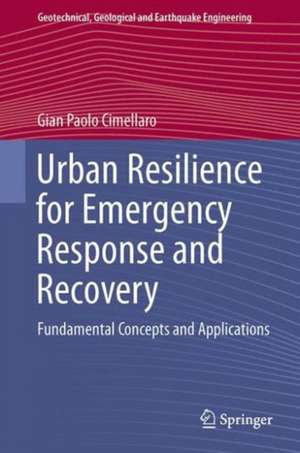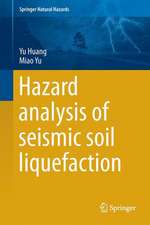Urban Resilience for Emergency Response and Recovery: Fundamental Concepts and Applications: Geotechnical, Geological and Earthquake Engineering, cartea 41
Autor Gian Paolo Cimellaroen Limba Engleză Hardback – 31 mai 2016
This book introduces the concepts of Resilience-Based Design (RBD) as an extension of Performance-Based Design. It provides readers with a range of cutting-edge methodologies for evaluating resilience and clarifies the difference between resilience, vulnerability and sustainability. Initially, the book focuses on describing the different types of uncertainty that arise in the context of resilience evaluation. This is followed by an entire chapter dedicated to the analytical and experimental recovery functions. Then, starting from the definition of resilience provided by MCEER, an extension of the methodology is provided that introduces the seven dimensions of Community Resilience, summarized in the acronym PEOPLES. They are: Population and Demographics, Environmental/Ecosystem, Organized Governmental Services, Physical infrastructures, Lifestyle and Community Competence, Economic Development, and Socio-Cultural Capital. For each dimension, components and subcomponents are definedand the related indices are provided.
Underlining the importance of the physical infrastructure dimension, the book provides several examples of applications for transportation, hydraulic, gas and power networks. The problem of interdependencies and the domino effect is also taken into account during the analysis. One of the book’s closing chapters focuses on different methodologies for improving disaster preparedness and engineering mitigation strategies, while the last chapter describes the different computer platforms available on the market for evaluating Community Resilience.
The book offers readers an extensive introduction to the concept of Resilience-Based Design, together with selected advanced applications for specialists. No prerequisite knowledge is needed in order to understand the book, and the Appendix offers valuable supplemental information on e.g. the probabilistic concepts. As such, the book offers a valuable resourcefor graduate students, young engineers and researchers who are interested in the topic, and can also be used as a supplementary text in graduate level Disaster Resilience courses.
| Toate formatele și edițiile | Preț | Express |
|---|---|---|
| Paperback (1) | 942.94 lei 38-45 zile | |
| Springer International Publishing – 30 mai 2018 | 942.94 lei 38-45 zile | |
| Hardback (1) | 1405.90 lei 3-5 săpt. | |
| Springer International Publishing – 31 mai 2016 | 1405.90 lei 3-5 săpt. |
Din seria Geotechnical, Geological and Earthquake Engineering
- 15%
 Preț: 665.73 lei
Preț: 665.73 lei - 15%
 Preț: 717.59 lei
Preț: 717.59 lei - 18%
 Preț: 959.19 lei
Preț: 959.19 lei - 15%
 Preț: 656.43 lei
Preț: 656.43 lei - 18%
 Preț: 1944.11 lei
Preț: 1944.11 lei -
 Preț: 392.60 lei
Preț: 392.60 lei - 18%
 Preț: 954.62 lei
Preț: 954.62 lei - 18%
 Preț: 954.45 lei
Preț: 954.45 lei - 15%
 Preț: 638.24 lei
Preț: 638.24 lei - 18%
 Preț: 954.45 lei
Preț: 954.45 lei - 15%
 Preț: 640.24 lei
Preț: 640.24 lei - 20%
 Preț: 572.65 lei
Preț: 572.65 lei - 24%
 Preț: 805.40 lei
Preț: 805.40 lei - 20%
 Preț: 602.78 lei
Preț: 602.78 lei - 15%
 Preț: 639.08 lei
Preț: 639.08 lei - 18%
 Preț: 1242.83 lei
Preț: 1242.83 lei - 15%
 Preț: 639.73 lei
Preț: 639.73 lei - 15%
 Preț: 637.46 lei
Preț: 637.46 lei - 18%
 Preț: 1222.01 lei
Preț: 1222.01 lei - 18%
 Preț: 967.08 lei
Preț: 967.08 lei - 18%
 Preț: 959.98 lei
Preț: 959.98 lei - 15%
 Preț: 658.88 lei
Preț: 658.88 lei - 18%
 Preț: 969.44 lei
Preț: 969.44 lei - 15%
 Preț: 653.79 lei
Preț: 653.79 lei - 15%
 Preț: 657.73 lei
Preț: 657.73 lei - 18%
 Preț: 961.55 lei
Preț: 961.55 lei - 15%
 Preț: 652.49 lei
Preț: 652.49 lei - 18%
 Preț: 961.86 lei
Preț: 961.86 lei - 15%
 Preț: 649.06 lei
Preț: 649.06 lei -
 Preț: 450.02 lei
Preț: 450.02 lei - 18%
 Preț: 967.22 lei
Preț: 967.22 lei - 18%
 Preț: 1117.99 lei
Preț: 1117.99 lei - 15%
 Preț: 656.58 lei
Preț: 656.58 lei
Preț: 1405.90 lei
Preț vechi: 1714.50 lei
-18% Nou
Puncte Express: 2109
Preț estimativ în valută:
269.03€ • 287.67$ • 224.30£
269.03€ • 287.67$ • 224.30£
Carte disponibilă
Livrare economică 28 martie-11 aprilie
Preluare comenzi: 021 569.72.76
Specificații
ISBN-13: 9783319306551
ISBN-10: 3319306553
Pagini: 512
Ilustrații: XXVI, 522 p. 309 illus., 126 illus. in color.
Dimensiuni: 155 x 235 x 33 mm
Greutate: 1.16 kg
Ediția:1st ed. 2016
Editura: Springer International Publishing
Colecția Springer
Seria Geotechnical, Geological and Earthquake Engineering
Locul publicării:Cham, Switzerland
ISBN-10: 3319306553
Pagini: 512
Ilustrații: XXVI, 522 p. 309 illus., 126 illus. in color.
Dimensiuni: 155 x 235 x 33 mm
Greutate: 1.16 kg
Ediția:1st ed. 2016
Editura: Springer International Publishing
Colecția Springer
Seria Geotechnical, Geological and Earthquake Engineering
Locul publicării:Cham, Switzerland
Cuprins
1. Introduction.- 2. Resilience-Based Design.- 3. Resilience Indicators.- 4. Damage Loss Assessment Models.- 5. Downtime and Recovery Models.- 6. PEOPLES Resilience Framework.- 7. A Comprehensive Methodology for the Evaluation of Infrastructure Interdependencies.- 8. The Physical Infrastructure Dimension of Community Resilience Framework.- 9. The Physical Infrastructure Dimension Taking into Account Interdependencies.- 10. Applications of Seismic Resilience for Healthcare Facilities and School Buildings.- 11. A Model to Evaluate Disaster Resilience of an Emergency Department.- 12. Application of Economic Resiliency of Communities Affected by Natural Disasters.- 13. Building More Resilient Communities.- 14. Computational Tools and Software for Resilience Assessment.- Appendix.- Index.
Textul de pe ultima copertă
This book introduces the concepts of Resilience-Based Design (RBD) as an extension of Performance-Based Design. It provides readers with a range of cutting-edge methodologies for evaluating resilience and clarifies the difference between resilience, vulnerability and sustainability. Initially, the book focuses on describing the different types of uncertainty that arise in the context of resilience evaluation. This is followed by an entire chapter dedicated to the analytical and experimental recovery functions. Then, starting from the definition of resilience provided by MCEER, an extension of the methodology is provided that introduces the seven dimensions of Community Resilience, summarized in the acronym PEOPLES. They are: Population and Demographics, Environmental/Ecosystem, Organized Governmental Services, Physical infrastructures, Lifestyle and Community Competence, Economic Development, and Socio-Cultural Capital. For each dimension, components and subcomponents are definedand the related indices are provided.
Underlining the importance of the physical infrastructure dimension, the book provides several examples of applications for transportation, hydraulic, gas and power networks. The problem of interdependencies and the domino effect is also taken into account during the analysis. One of the book’s closing chapters focuses on different methodologies for improving disaster preparedness and engineering mitigation strategies, while the last chapter describes the different computer platforms available on the market for evaluating Community Resilience.
The book offers readers an extensive introduction to the concept of Resilience-Based Design, together with selected advanced applications for specialists. No prerequisite knowledge is needed in order to understand the book, and the Appendix offers valuable supplemental information on e.g. the probabilistic concepts. As such, the book offers a valuable resource for graduate students, young engineers and researchers who are interested in the topic, and can also be used as a supplementary text in graduate level Disaster Resilience courses.
Caracteristici
Presents high quality research advancements in disaster resilience with an international approach Offers a unique fusion of technical, organizational, social and economic aspects of resilience Covers fundamental concepts, applications and illustrations of disaster resilience Introduces Resilience-Based Design (RBD) as an extension of Performance-Based Design (PBD) with an international scope Clarifies the difference between resilience, vulnerability and sustainability Covers the 7 dimensions of resilience included by PEOPLES Focuses on the infrastructure dimension, with applications to transportation and hydraulic, gas and electric networks















